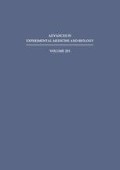Abstract
The endogenous excitatory amino acids aspartate and glutamate are considered the most likely candidates as putative transmitters in the mammalian CNS. They act on one or more receptors. On the basis of electrophysiological studies, using mainly spinal cord preparations, three classes of excitatory amino acid receptors have been proposed: NMDA, quisqualate and kainate (Watkins and Evans, 1981).
Access this chapter
Tax calculation will be finalised at checkout
Purchases are for personal use only
Preview
Unable to display preview. Download preview PDF.
References
Adams, P.R. 1976, Drug blockade of open end-plate channels, J. Physiol., 260:531.
Aitken, P.G., 1985, Kainic acid and penicillin: differential effects on excitatory and inhibitory interactions in the CA1 region of the hippocampal slice, Brain Res., 325: 261.
Aldenhoff, J.B., Gruol, D.L., Rivier, J., Vale, W., and Siggins, G.R., 1983, Corticotropin releasing factor decreases postburst hyperpolarizations and excites hippocampal neurons, Science, 221: 875.
Barrett, E.F., Barret, J.N., and Crill, W.E., 1980, Voltage sensitive outward currents in cat motoneurones, J. Physiol., 304:251.
Ben-Ari, Y., 1985, Limbic seizure and brain damage produced by kainie acid: mechanisms and relevance to human temporal lobe epilepsy, Neuroscience, 14: 375.
Collingridge, G.L., Kehl, S.J., Loo, R., and McLennan, H., 1983, Effects of kainic and other amino acids on synaptic excitation in rat hippocampal slices: 1. Extracellular analysis, Exp. Brain Res., 52:170.
Colquhoun, D., 1981, The kinetics of conductance changes at nicotinic receptors of the muscle end-plate and of ganglia, in: Drug Receptors and Their Effectors, N.J.M. Birdsall, ed., MacMillan, London, p. 107.
Di Francesco, D., and Ojeda, C., 1980, Properties of the current in the sino-atrial node of the rabbit compared with those of the current iK2 in Purkinje fibres, J. Physiol., 308:353.
Dingledine, R., 1983, N-methyl aspartate activates voltage-dependent calcium conductance in rat hippocampal pyramidal cells, J, Phvsiol., 343:385.
Fisher, R.A., and Alger, R.E., 1984, Electrophysiological mechanisms of kainie acid induced epileptiform activity in the rat hippocampal slice, J. Neurosci., 4:1323.
Gormann, A.L.F., and Hermann, A., 1979, Internal effects of divalent cations on potassium permeability in molluscan neurones, J. Physiol., 296:393.
Gustafsson, B., and Wigström, H., Evidence for two types of afterhyperpolari- zation in CA1 pyramidal cells in the hippocampus, Brain Res., 206: 462.
Haas, H.L., and Konnerth, A., 1983, Histamine and noradrenaline decrease calcium activated potassium conductance in hippocampal pyramidal cells, Nature, 302: 432.
Hablitz, J.J., and Johnston, D., 1981, Endogenous nature of spontaneous bursting in hippocampal pyramidal neurons, Cell.. Mol. Neurobiol., 1:325.
Halliwell, J.V., and Adams, P.R., 1982, Voltage-clamp analysis of muscarinic excitation in hippocampal neurons, Brain Res., 250: 71.
Hoston, J.R., Prince, D.A., and Schwartzkroin, P.A., 1979, Anomalous inward rectification in hippocampal neurones, J. Neurophysiol., 42:889.
Ishida, A.T., and Neyton, J., Quisqualate and L-glutamate inhibit retinal horizontal-cell responses to kainate, Proc. Natl.. Acad. Sci. USA, 82:1837.
Kaneko, A., and Tachibana, M., 1985, Effects of L-glutamate on the anomalous rectifier potassium current in horizontal cells of carassius auratus retina, J. Physiol., 358:169.
Kramer, R.H., and Zucker, R.S., 1985, Calcium-induced inactivation of calcium current causes the interburst hyperpolarization of Aplvsia bursting neurones, J. Physiol., 362:131.
Madison, D.V., and Nicoll, R.A., 1982, Noradrenaline blocks accommodation of pyramidal cell discharge in the hippocampus, Nature, 299: 636.
Madison, D.V., and Nicoll, R.A., 1984, Control of the repetitive discharge of rat CA1 pyramidal neurones in vitro, J. Phvsiol., 354:319.
North, R.A., Morita, K., and Tokimasa, T., 1983, Peptide actions on autonomic nerves, in: Systemic Role of Regulatory Peptides, S.R. Bloom, J.M.
Polak,and E.Lindenlaub,eds.,Springer-Verlag,Stuttgart-New York,P.77.
North, R.A., and Tokimasa, T., 1983, Depression of calcium-dependent potassium conductance by muscarinic agonists, J. Phvsiol., 342:253.
Nowak, L., Bregestovski, P., Asher, P., Herbet, A., and Prochiantz, A., 1984, Magnesium gates glutamate-activated channels in mouse central neurones, Nature, 307: 462.
Pepper, C., and Henderson, G., 1980, Opiates and opioid peptides hyperpolarize locus coeruleus neurones in vitro, Science, 209:394.
Robinson, J.H., and Deadwyler, S.A., 1981, Kainic acid produces depolarization of CA3 pyramidal cells in the in vitro hippocampal slice, Brain Res., 221: 117.
Tachibana, M., 1985,. Permeability changes induced by L-glutamate in solitary retinal horizontal cells isolated from Carassius Auratus, J. Physiol., 358:153.
Tillotson, D., 1979,. Inactivation of Ca conductance dependent on entry of Ca ions in molluscan neurons, Proc. Natl. Acad. Sci. USA, 76:1497.
Tokimasa, T., 1984, Muscarinic agonists depress calcium-dependent gk in bullfrog sympathetic neurons, J. Autonom. Nerv. Syst., 10:107.
Watkins, J.C., and Evans, R.H., 1981, Excitatory amino acid transmitters, Ann. Rev. Pharmacol. Toxicol., 21:165.
Author information
Authors and Affiliations
Editor information
Editors and Affiliations
Rights and permissions
Copyright information
© 1986 Plenum Press, New York
About this chapter
Cite this chapter
Cherubini, E., Rovira, C., Gho, M., Ben-Ari, Y. (1986). Effects of Kainate on CA1 Hippocampal Neurons Recorded in Vitro . In: Schwarcz, R., Ben-Ari, Y. (eds) Excitatory Amino Acids and Epilepsy. Advances in Experimental Medicine and Biology, vol 203. Springer, Boston, MA. https://doi.org/10.1007/978-1-4684-7971-3_36
Download citation
DOI: https://doi.org/10.1007/978-1-4684-7971-3_36
Publisher Name: Springer, Boston, MA
Print ISBN: 978-1-4684-7973-7
Online ISBN: 978-1-4684-7971-3
eBook Packages: Springer Book Archive

